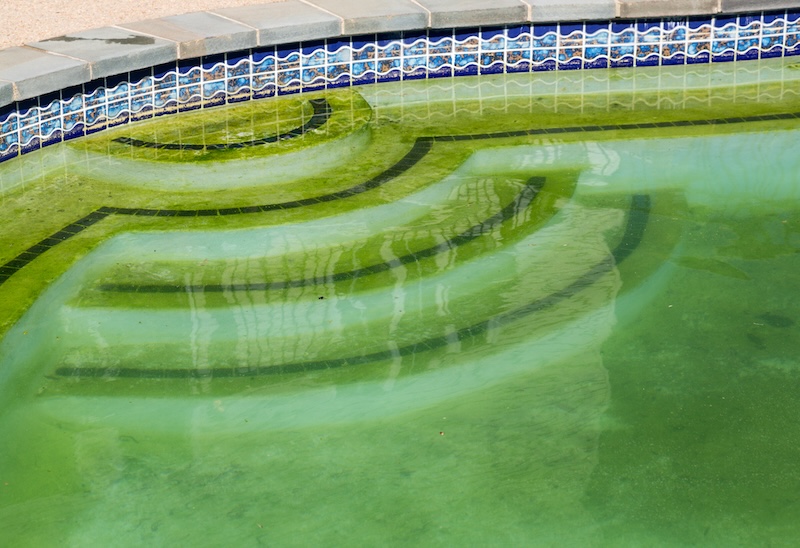As a pool owner, you know keeping it in good shape is key. One of the most common issues is algae—tiny plant-like organisms that can affect water clarity. If you’ve noticed green, black, or yellowish tints in the pool or a film on the surface, chances are you’ve got some algae sneaking in.
The term algae may seem broad — and you’re right to think so. Several types of algae can inhabit your pool, each with unique characteristics and treatment methods. These include the commonly seen green algae, stubborn black algae, sneaking mustard algae, and even pink algae.
Identifying and understanding the types of algae that can plague your pool isn’t just about improving aesthetics. It’s about safeguarding your family’s health, maintaining the longevity of your pool’s surfaces, and ensuring a delightful swimming experience. No one wants to plan a splash-filled summer day, only to be derailed by murky, potentially unhealthy pool water.
With the right knowledge and a bit of elbow grease, you can learn how to spot, combat, and prevent algae invasions. Let’s dive right in and uncover the most common types of pool algae, how they can affect your pool, and what you can do about it!
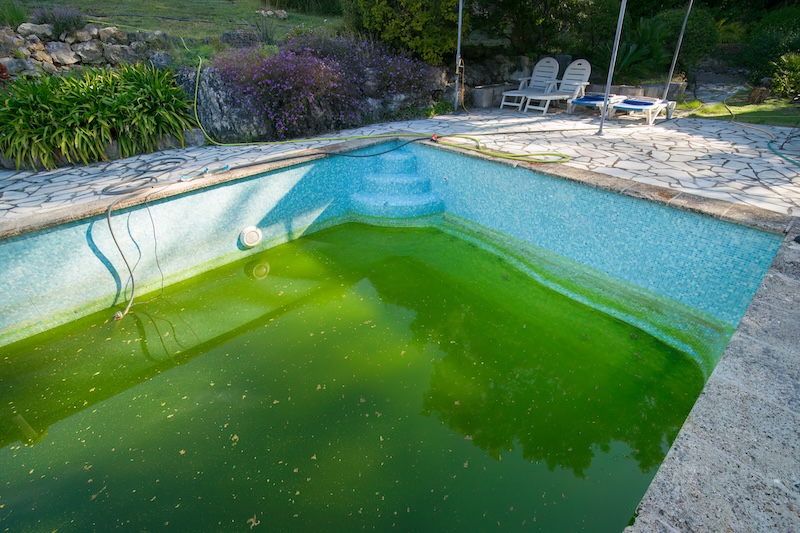
Recognizing Different Types of Pool Algae
To effectively maintain your pool and ensure a clean swimming environment, understanding the different types of algae you might encounter is crucial. Here’s a more detailed look at each type:
Green Algae
Commonly known as Chlorophyta, green algae is the most frequently seen type you’ll encounter in a pool setting. It’s named for the distinct green hue it brings to pool water. Green algae often strike as a result of poor circulation or filtration, as well as improper chlorine levels. This pesky hitchhiker can free-float in your pool water, or cling to your pool walls and floor, causing them to feel slippery to touch. It’s relatively easy to get rid of with a thorough pool cleaning and by maintaining the correct balance of pool chemicals.
Blue-Green Algae
Blue-green algae might sound like a type of algae, but it’s actually a type of bacteria called cyanobacteria. These tiny organisms love warm, nutrient-rich water and can release toxins that are dangerous for both people and pets. They’re not common in properly chlorinated pools, but it’s still smart to keep your filtration and disinfection systems running well to help prevent them.
Mustard Algae (Yellow Algae)
Characterized by its mustard yellow or brown color, this type of algae is slightly more difficult to spot as it can be mistaken for dirt or sand. Its preference for shady areas makes the secluded and less accessible sections of your pool a prime target. Mustard algae present a challenge as it’s more resistant to normal chlorine levels than other types, making it harder to eliminate and more likely to persist even after treatment.
Black Algae
For a pool owner, the news of black algae is not something you want to hear. It is the most difficult type of algae to eradicate due to its strong roots that penetrate pool surfaces—especially plastered or porous ones—and the slimy protective layer that shields it against pool chemicals. You will identify black algae as dark black or blue-green spots, most commonly found on the sides and bottom of your swimming pool. To treat black algae, scrub the affected areas thoroughly, then apply a high-quality algaecide and keep your pool’s chlorine levels high to break through its protective layer and root structure.
Pink Algae
The soft pink or red you’ll occasionally notice in your pool is pink algae. However, it’s not genuinely an algae but a form of bacteria. Often found in corners where water flow is weak, pink algae typically takes on a slimy consistency which can be quite off-putting, and gets its rosy color from the pigment of the bacterial cells.
Each type of pool algae has specific characteristics, behaviors, and methods for control and mitigation. Understanding these differences can lead to more effective pool maintenance and a cleaner, healthier swimming experience. In the next section, we will discuss the impacts and implications of these algae in your pool.
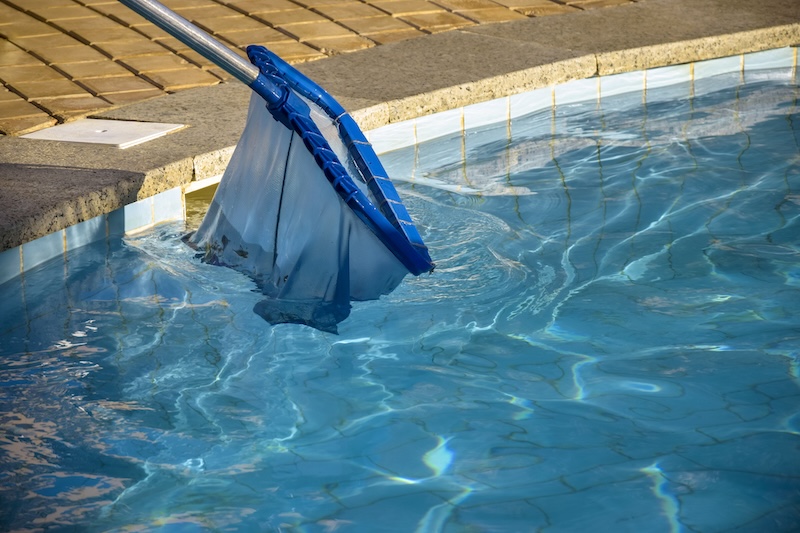
Impacts and Consequences of Algae in Pools
Algae aren’t just an eyesore—they have far-reaching impacts on your pool and can be an indicator of more significant problems. Let’s jump into the various implications of the different types of algae in your swimming pool.
Altering Pool’s Appearance
Algae, especially the green and black types, can quickly alter the color and visibility of your pool water. From shiny clear to a murky green, or even a cloudy blue-green, algae can turn your swimming pool into an unsightly mess. Algae growth on pool surfaces or walls can make them slippery, which poses a safety risk for swimmers.
Health Risks
Algae create an environment favorable for the growth of harmful bacteria, including E. Coli. Certain types of algae, like blue-green algae, can produce toxins that pose health risks to people and pets. Swimmers may experience skin irritations or, in the worst-case scenario, gastrointestinal illnesses.
Impact on Pool’s Filtration and Circulation System
Algae spores can clog your pool filter, leading to poor circulation and filtration – conditions where algae thrive. A high presence of algae often indicates that your pool’s filtration system needs to be checked and your pool water’s chemical balance needs adjustment.
Knowing the impacts and consequences of algae in your pool is critical in understanding the importance of regular maintenance and proactive prevention measures. While every algae is a pain, not every algae responds to the same treatment.
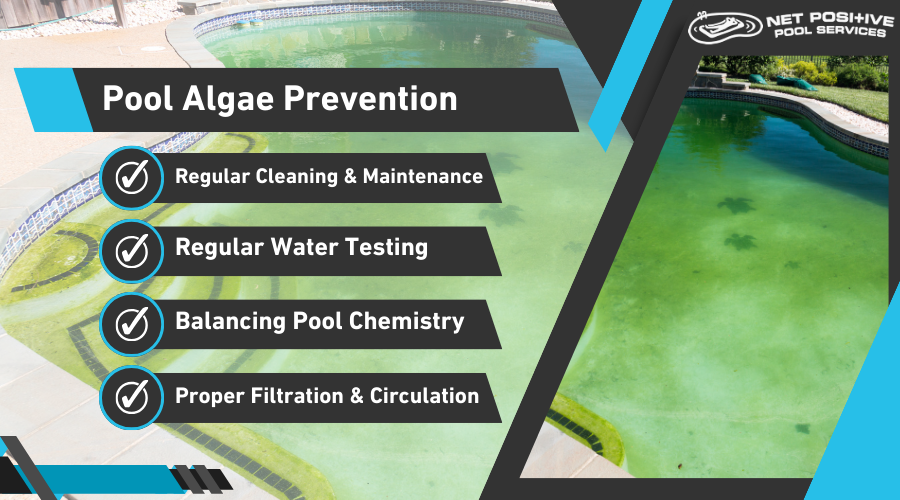
Prevention and Regular Maintenance for a Sparkling Clean Pool
Algae might seem like a mighty enemy for any pool owner, but with the correct preventive measures, you can greatly minimize the chances of an algae invasion in your swimming pool.
1. Regular Pool Cleaning & Maintenance
This cannot be stressed enough: maintaining regular cleaning and sustaining an optimal chemical balance is a must for preventing algae growth. Regular brushing of pool walls, floor, and stairs prevents algae spores from taking hold and growing—especially on porous surfaces and corners that might not get enough attention from your pool’s circulation system. Cleaning pool filters often and running your pool pump for at least 8 hours a day will further keep your pool water moving and discourage algae proliferation.
2. Regular Pool Water Testing
To effectively prevent pool algae, regularly test and adjust, if necessary, your pool’s pH level, chlorine level, and cyanuric acid level. Maintaining these elements at the right concentrations can deter algae growth and make your pool less inviting for these pests.
3. Balancing Pool Chemistry
Proper chemical balance is essential in keeping algae away. Overly high pH (above 7.8) can render chlorine less effective. On the other hand, under a certain level of calcium hardness, your pool water can become corrosive. Maintaining an optimal balance ensures your pool environment isn’t conducive to algae formation.
4. Proper Filtration and Circulation
Ensure your pool’s circulation and filtration systems are functioning efficiently. Stagnant areas or poor water circulation can provide an excellent habitat for algae to grow. Regular maintenance can help avoid such situations.
Prevention is always better than the cure, especially when it comes to algae in your pool. Implementing these measures alongside prompt clean-up of organic debris such as leaves or grass clippings, which might introduce algae spores into your pool, can go a long way in maintaining clear, sparkling water.
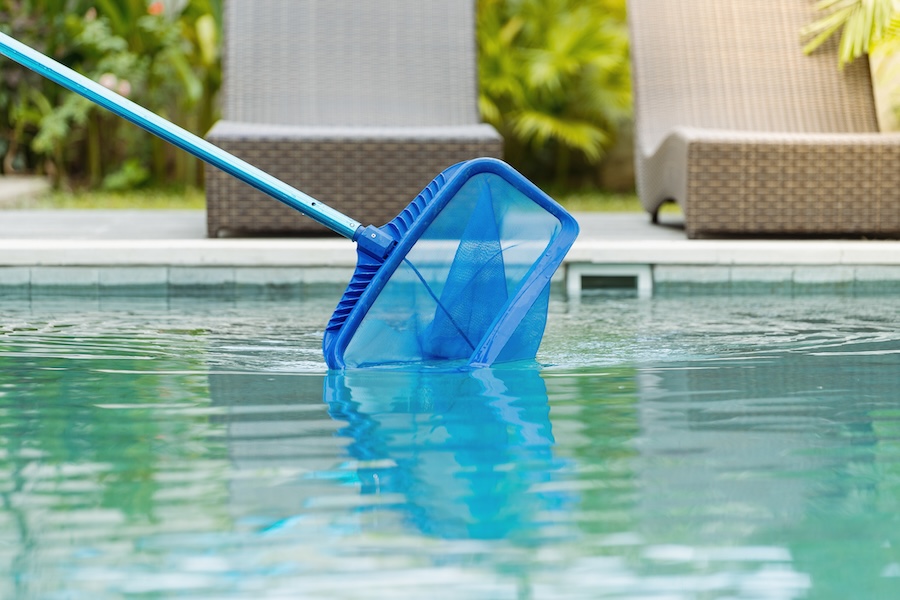
Stay Algae-Free with Net Positive
At Net Positive Pool Services, we understand the challenges algae can bring to your pool’s clarity and safety. Our expert pool services are designed to tackle algae blooms head-on, ensuring your pool water stays clean and clear.
From weekly maintenance and free water testing to targeted treatments for stubborn algae types like black and mustard algae, we handle it all, so you don’t have to. With our tailored solutions, you can enjoy a sparkling, healthy pool year-round, leaving algae worries behind!
With 8 locations in North and South Carolina, contact us today to see how we can serve you!
